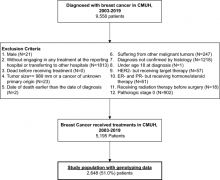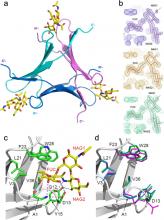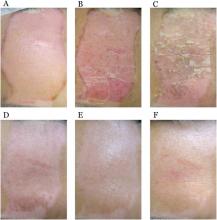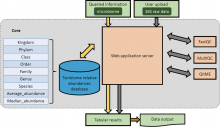研究成果

Jan, 2024
Purpose: Breast cancer is a molecularly heterogeneous disease, and multiple genetic variants contribute to its development and prognosis. Most of previous genome-wide association studies (GWASs) and polygenic risk scores (PRSs) analyses focused on studying breast cancers of Caucasian populations, which may not be applicable to other population. Therefore, we conducted the largest breast cancer cohort of Taiwanese population to fill in the knowledge gap.
Methods: A total of 152,534 Participants recruited by China Medical University Hospital between 2003 and 2019 were filtered by several patient selection criteria and GWAS quality control steps, resulting in the inclusion of 2496 cases and 9984 controls for this study. We then conducted GWAS for all breast cancers and PRS analyses for all...

Jan, 2024
PhoSL (Pholiota squarrosa Lectin) has an exceptional binding affinity for biomolecules with core-fucosylated N-glycans. This modification involves the addition of fucose to the inner N-acetylglucosamine within the N-glycan structure and is known to influence many physiological processes. Nevertheless, the molecular interactions underlying high-affinity binding of native PhoSL to core-fucosylated N-glycans remain largely unknown. In this study, we devised a strategy to produce PhoSL with the essential structural characteristics of the native protein (n-PhoSL). To do so, a fusion protein was expressed in E. coli and purified. Then, enzymatic cleavage and incubation with glutathione were utilized to recapitulate the native primary structure and disulfide bonding pattern. Subsequently, we...

Dec, 2023
Vitiligo is a common acquired disease of pigment loss. In lesions recalcitrant to non-invasive treatment, transplantation of cultured autologous melanocytes is an emerging choice. Conventionally, the recipient site is often prepared by laser-mediated or mechanical dermabrasion. Such preparation procedures have disadvantages including prolonged transplantation duration, long period for reepithelialization and potential scarring. We propose a method of preparing recipient sites by psoralen and controlled ultraviolet A (PUVA)-induced blistering followed by transplanting suspended melanocytes. We introduced this method in 10 patients with segmental vitiligo on their recipient site 3 to 5 days before transplantation and blistering developed in 2 to 3 days afterwards. On the day of...

Dec, 2023
With new advances in next generation sequencing (NGS) technology at reduced costs, research on bacterial genomes in the environment has become affordable. Compared to traditional methods, NGS provides high-throughput sequencing reads and the ability to identify many species in the microbiome that were previously unknown. Numerous bioinformatics tools and algorithms have been developed to conduct such analyses. However, in order to obtain biologically meaningful results, the researcher must select the proper tools and combine them to construct an efficient pipeline. This complex procedure may include tens of tools, each of which require correct parameter settings. Furthermore, an NGS data analysis involves multiple series of command-line tools and requires extensive computational resources...

Dec, 2023
Mechanical signaling plays a crucial role in maintaining extracellular matrix (ECM) homeostasis in various structures. In this study, we investigated the responses of corneal fibroblasts to cyclic stretching loads using an in vitro cell culture system. Bovine corneal fibroblasts were cultured and subjected to equibiaxial cyclic strain of 15% for 72 h at a frequency of 0.25 Hz, with bovine skin fibroblasts used as a comparison. We explored various cellular behaviors, including morphological changes, cell proliferation, and metabolism in response to mechanical stretching loads. The expression of genes, protein secretion, and enzymatic activity for several major metalloproteinases was also determined through Q-PCR, Western blot, and gel zymography. Additionally, we investigated the...

Nov, 2023
Polygenic risk score (PRS) predictions often show bias toward the population of available genome-wide association studies (GWASs), which is typically of European ancestry. This study aimed to assess the performance differences of ancestry-specific PRS and test the implementation of multi-ancestry PRS to enhance the generalizability of low-density lipoprotein (LDL) cholesterol predictions in the East Asian (EAS) population. In this study, we computed ancestry-specific and multi-ancestry PRSs for LDL using data obtained from the Global Lipid Genetics Consortium, while accounting for population-specific linkage disequilibrium patterns using the PRS-CSx method in the United Kingdom Biobank dataset (UKB, n = 423,596) and Taiwan Biobank dataset (TWB, n = 68,978). Population-specific PRSs were...

Nov, 2023
Context: Recent studies suggest that the clinical characteristics and biological behavior of pituitary tumors (PITs) in patients with multiple endocrine neoplasia type 1 (MEN1) may not be as aggressive as previously reported. Increased imaging of the pituitary as recommended by screening guidelines identifies more tumors, potentially at an earlier stage. However, it is unknown if these tumors have different clinical characteristics in different MEN1 mutations.
Objective: To assess characteristics of patients with MEN1 with and without PITs, and compare among different MEN1 mutations.
Methods: Data of patients with MEN1 in a tertiary referral center from 2010 to 2023 were retrospectively analyzed.
Results: Forty-two patients with MEN1 were included. Twenty-four patients had PITs, 3 of...

Nov, 2023
Objective: Unilateral sensorineural hearing loss (USNHL) is a condition commonly encountered in otolaryngology clinics. However, its molecular pathogenesis remains unclear. This study aimed to investigate the genetic underpinnings of childhood USNHL and analyze the associated audiological features.
Study design: Retrospective analysis of a prospectively recruited cohort.
Setting: Tertiary referral center.
Methods: We enrolled 38 children with USNHL between January 1, 2018, and December 31, 2021, and performed physical, audiological, imaging, and congenital cytomegalovirus (cCMV) examinations as well as genetic testing using next-generation sequencing (NGS) targeting 30 deafness genes. The audiological results were compared across different etiologies.
Results: Causative genetic...

Nov, 2023
Recessive variants in GJB2 are the most important genetic cause of sensorineural hearing impairment (SNHI) worldwide. Phenotypes vary significantly in GJB2-related SNHI, even in patients with identical variants. For instance, patients homozygous for the GJB2 p.V37I variant, which is highly prevalent in the Asian populations, usually present with mild-to-moderate SNHI; yet severe-to-profound SNHI is occasionally observed in approximately 10% of p.V37I homozygotes. To investigate the genomic underpinnings of the phenotypic variability, we performed next-generation sequencing of GJB2 and other deafness genes in 63 p.V37I homozygotes with extreme phenotypic severities. Additional pathogenic variants of other deafness genes were identified in five of the 35 patients with severe-to-profound...

Nov, 2023
The immune checkpoint inhibitor (ICI), anti-programmed death-1 (anti-PD-1), has shown moderate efficacy in some patients with head and neck squamous cell carcinoma (HNSCC). Because of this, it is imperative to establish a mouse tumor model to explore mechanisms of antitumor immunity and to develop novel therapeutic options. Here, we examined the 4-nitroquinoline-1-oxide (4NQO)-induced oral squamous cell carcinoma (OSCC) model for genetic aberrations, transcriptomic profiles, and immune cell composition at different pathologic stages. Genomic exome analysis in OSCC-bearing mice showed conservation of critical mutations found in human HNSCC. Transcriptomic data revealed that a key signature comprised of immune-related genes was increased beginning at the moderate dysplasia stages. We first...